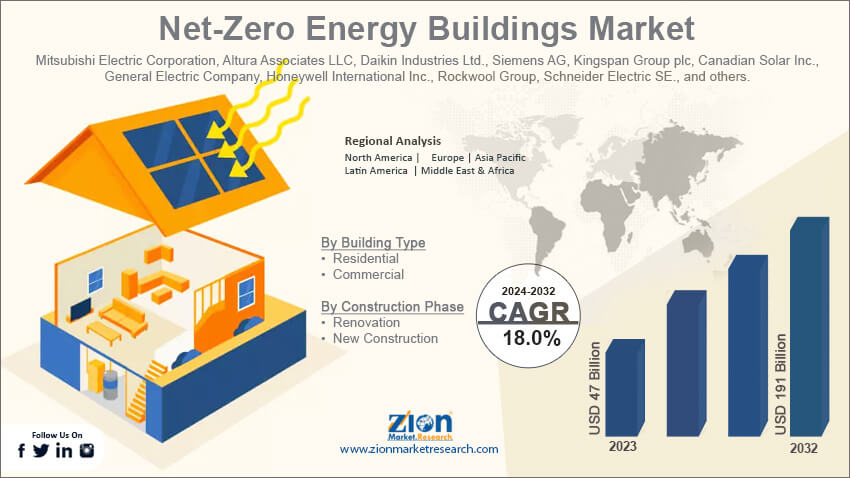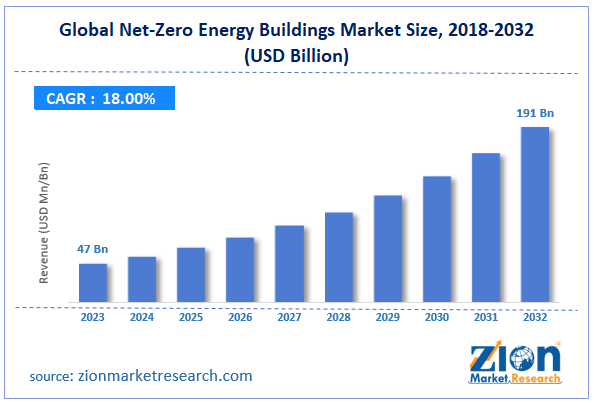Net-Zero Energy Buildings Market Size, Share, Analysis, Trends, Growth, Forecasts, 2032

Net-Zero Energy Buildings Market By Building Type (Residential and Commercial), By Construction Phase (Renovation and New Construction), and By Region - Global and Regional Industry Overview, Market Intelligence, Comprehensive Analysis, Historical Data, and Forecasts 2024 - 2032-
| Market Size in 2023 | Market Forecast in 2032 | CAGR (in %) | Base Year |
|---|---|---|---|
| USD 47 Billion | USD 191 Billion | 18% | 2023 |
Net-Zero Energy Buildings Industry Prospective:
The global net-zero energy buildings market size was evaluated at $47 billion in 2023 and is slated to hit $191 billion by the end of 2032 with a CAGR of nearly 18% between 2024 and 2032.
Net-Zero Energy Buildings Market: Overview
Net-zero energy buildings are structures designed to produce only the energy needed for yearly consumption. Apart from this, they help achieve a balance between energy usage and production. Furthermore, the large-scale popularity of net-zero energy buildings can be attributed to the surging requirement of maintaining a sustainable environment, the need to minimize carbon emissions, and the need to reduce energy consumption.
Key Insights
- s per the analysis shared by our research analyst, the global net-zero energy buildings market is projected to expand annually at the annual growth rate of around 18% over the forecast timespan (2024-2032)
- In terms of revenue, the global net-zero energy buildings market size was evaluated at nearly $47 billion in 2023 and is expected to reach $191 billion by 2032.
- The global net-zero energy buildings market is anticipated to grow rapidly over the forecast timespan owing to new technological breakthroughs such as innovations in PV tools and solar panels along with an immense increment in the use of geothermal & wind energy.
- In terms of building type, the residential segment is slated to register the highest CAGR over the forecast period.
- Based on construction phase, the new construction segment is predicted to record immense growth in the upcoming years.
- Region-wise, the Asia-Pacific net-zero energy buildings industry is projected to register the fastest CAGR during the projected timespan.
 Request Free Sample
Request Free Sample
Net-Zero Energy Buildings Market: Growth Factors
Launch of green technologies in construction activities will drive the global market surge by 2032
New technological breakthroughs, such as innovations in PV tools and solar panels, along with an immense increment in the use of geothermal & wind energy, have culminated in massive global net-zero energy buildings market demand. Moreover, constant enhancements in energy management systems, along with their integration with renewable energy sources, will drive the market trends globally.
Furthermore, the need to improve the proficiency of buildings will scale up the expansion of the market globally. Adoption of NZEB practices and the need for strict laws related to green building certifications can proliferate the size of the global market.
Moreover, benefits offered by net-zero energy buildings include environmental sustainability, enhanced indoor air quality, financial benefits, and comfortable living provided by advanced HVAC systems & efficient insulation tools.
Net-Zero Energy Buildings Market: Restraints
Need for high fund allocation for new constructions can hinder the global industry surge over 2024-2032
The necessity of huge initial investments in deploying solar panels or solar cells (PV cells) can inhibit the expansion of the global net-zero energy building industry. Furthermore, technological limitations and changing government policies can shrink the global industry expansion.
Net-Zero Energy Buildings Market: Opportunities
Supportive government schemes can open new horizons for global market growth in the coming years
Favorable government initiatives such as tax incentives and grants, along with a growing preference for reducing power utility bills, can open new panoramas of growth for the global net-zero energy buildings market. Moreover, constructions with low energy charges and enhanced power conservation have led to an increment in the real-estate prices, thereby scaling up the global market surge.
Net-Zero Energy Buildings Market: Challenges
Lesser know-how of advantages provided by green edifices can obstruct the global industry progress in the forthcoming years
Lack of awareness about the benefits offered by net-zero energy buildings to homeowners can deter the growth of the global net-zero energy buildings industry. Additionally, the non-uniform policies of lawmakers and supply chain limitations can further demean the industry space in the coming years.
Net-Zero Energy Buildings Market: Segmentation
The global net-zero energy buildings market is divided into building type, construction phase, and region.
In terms of building type, the net-zero energy buildings market across the globe is segmented into residential and commercial segments. Apparently, the residential segment, which amassed nearly 54% of the global market revenue in 2023, is anticipated to record the fastest CAGR in the coming seven years due to an increase in the number of homeowners as well as renters across the globe with an increase in the migration population. Additionally, growing investments in rental properties are likely to augment the segmental surge.
Based on the construction phase, the global net-zero energy buildings industry is segmented into renovation and new construction segments. Apparently, the new construction segment, which accounted hugely to the global industry revenue in 2023, is anticipated to register lucrative growth in the ensuing years. This can be credited to the cost-efficiency and demand for new designs by the house owners for improving power efficiency and reducing energy wastage in buildings.
Net-Zero Energy Buildings Market: Report Scope
| Report Attributes | Report Details |
|---|---|
| Report Name | Net-Zero Energy Buildings Market |
| Market Size in 2023 | USD 47 Billion |
| Market Forecast in 2032 | USD 191 Billion |
| Growth Rate | CAGR of 18% |
| Number of Pages | 222 |
| Key Companies Covered | Mitsubishi Electric Corporation, Altura Associates LLC, Daikin Industries Ltd., Siemens AG, Kingspan Group plc, Canadian Solar Inc., General Electric Company, Honeywell International Inc., Rockwool Group, Schneider Electric SE., and others. |
| Segments Covered | By Building Type, By Construction Phase, and By Region |
| Regions Covered | North America, Europe, Asia Pacific (APAC), Latin America, Middle East, and Africa (MEA) |
| Base Year | 2023 |
| Historical Year | 2018 to 2022 |
| Forecast Year | 2024 - 2032 |
| Customization Scope | Avail customized purchase options to meet your exact research needs. Request For Customization |
Net-Zero Energy Buildings Market: Regional Insights
North America is likely to maintain leading status in the global market over the analysis timespan
North America, which contributed about 46% of the global net-zero energy buildings market earnings in 2023, is slated to establish a leading position in the global market in the coming few years. Additionally, the regional market progression in the next couple of years can be credited to supportive government policies and the launch of energy-efficient technologies in countries such as the U.S. Furthermore, supportive government incentives will spur regional market trends.
The Asia-Pacific net-zero energy buildings industry is likely to record the fastest compound annual growth rate in the forecast timeline. The elevation of the industry in Asia-Pacific can be a result of swift urbanization and a surge in construction activities in India and China. Apart from this, supportive government initiatives, along with the presence of giant firms in the sub-continent, will aid the progress of the industry in the APAC zone.
Key Developments
- In March 2024. Mahindra Lifespaces Developers Limited, the real estate & infrastructure development unit of Mahindra Group of Companies, introduced Mahindra Zen, a zero-waste energy residential venture in Bangalore, India.
Net-Zero Energy Buildings Market: Competitive Space
The global net-zero energy buildings market profiles key players such as:
- Mitsubishi Electric Corporation
- Altura Associates LLC
- Daikin Industries Ltd.
- Siemens AG
- Kingspan Group plc
- Canadian Solar Inc.
- General Electric Company
- Honeywell International Inc.
- Rockwool Group
- Schneider Electric SE.
The global net-zero energy buildings market is segmented as follows:
By Building Type
- Residential
- Commercial
By Construction Phase
- Renovation
- New Construction
By Region
- North America
- The U.S.
- Canada
- Europe
- France
- The UK
- Spain
- Germany
- Italy
- Rest of Europe
- Asia Pacific
- China
- Japan
- India
- South Korea
- Southeast Asia
- Rest of Asia Pacific
- Latin America
- Brazil
- Mexico
- Rest of Latin America
- Middle East & Africa
- GCC
- South Africa
- Rest of Middle East & Africa
Table Of Content
Methodology
FrequentlyAsked Questions
Net-zero energy buildings are structures designed to produce only the energy needed for yearly consumption. They also help achieve a balance between energy usage and production.
The global net-zero energy buildings market will grow over the forecast period due to the adoption of NZEB practices and the need for strict laws related to green building certifications.
According to a study, the global net-zero energy buildings industry size was $47 billion in 2023 and is projected to reach $191 billion by the end of 2032.
The global net-zero energy buildings market is anticipated to record a CAGR of nearly 18% from 2024 to 2032.
The Asia-Pacific net-zero energy buildings industry is set to register the fastest CAGR over the forecasting timeframe owing to swift urbanization and a surge in construction activities in India and China. Supportive government initiatives, along with the presence of giant firms in the subcontinent, will aid the industry's progress in the APAC zone.
The global net-zero energy buildings market is led by players such as Mitsubishi Electric Corporation, Altura Associates LLC, Daikin Industries Ltd., Siemens AG, Kingspan Group plc, Canadian Solar Inc., General Electric Company, Honeywell International Inc., Rockwool Group, and Schneider Electric SE.
The global net-zero energy buildings market report covers the geographical market along with a comprehensive competitive landscape analysis. It also includes cash flow analysis, profit ratio analysis, market basket analysis, cash-benefit analysis, market attractiveness analysis, sentiment analysis, PESTEL analysis, trend analysis, SWOT analysis, trade area analysis, demand & supply analysis, Porter’s five force analysis, factor analysis, and value chain analysis. It provides an apt scenario about demand and factor conditions in the country impacting the profitability of the firms in the domestic and international markets.
Choose License Type
HappyClients
Zion Market Research
Tel: +1 (302) 444-0166
USA/Canada Toll Free No.+1 (855) 465-4651
3rd Floor,
Mrunal Paradise, Opp Maharaja Hotel,
Pimple Gurav, Pune 411061,
Maharashtra, India
Phone No +91 7768 006 007, +91 7768 006 008
US OFFICE NO +1 (302) 444-0166
US/CAN TOLL FREE +1 (855) 465-4651
Email: sales@zionmarketresearch.com
We have secured system to process your transaction.
Our support available to help you 24 hours a day, five days a week.
Monday - Friday: 9AM - 6PM
Saturday - Sunday: Closed






